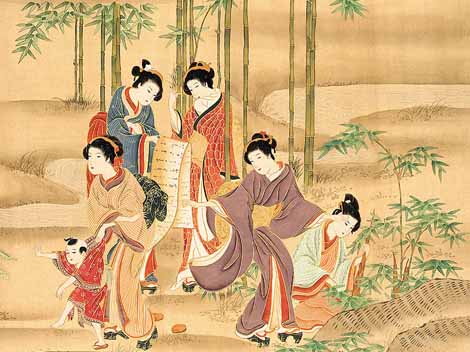There are various dynasties that influenced the styles of the ancient Chinese clothing or Ancient Chinese Dresses. From long robes to wide sleeves, each had their own distinct pattern, which made its mark.

Hanfu Ancient Chinese Dresses:
The Han Chinese clothing or the Hanfu dress developed during the Han Dynasty was one of the most prominent Ancient Chinese Dresses.
The history of the Hanfu dress dates as far back in time as the ancient group itself. It covered all the traditional Chinese clothing worn by people in that era.
This was the clothing worn by the common folk of the Han ethnic group of China. The Hanfu was considered to be very important by the Han Chinese as far as their culture was concerned. It was also known that one has to follow the rules of dressing that belonged to the Hanfu styles, as a mark of respect.
Style and design of ancient Chinese Hanfu dress:
The basic style and design of the Hanfu were developed to a great extent in the Shang Dynasty. The Shang dynasty saw 2 basic styles-The Yi and the Shang. The Yi is the coat worn on top and the Shang is the skirt that is worn beneath. There was a major use of sash instead of buttons and the sleeve cuffs were styled narrow. The colors of the fabrics were basically in warm tones.
The Western Zhou Dynasty also followed similar styles and designs of the Shang dynasty. In the Zhou dynasty, the system was perfect. There were rules about color, design, and adornment of clothes. These rules were made by the emperor and the officials. The color yellow was for the emperor only.
Green, red, white, and black were the symbols for north, south, east, and west. In this dynasty, one saw the variations in the sleeves narrow as well as broad. The lengths of the skirts saw different levels from the knee to the ankle. Here, the different styles that were worn also created a distinction between the people.
Robes used in ancient China:
The robes in Zhou Dynasty consisted of nine yellow dragons and five cloud patterns that were considered to be auspicious for the wearer. The dragon robe derived its name in the Qing Dynasty. The clouds on the robes further incorporated 12 patterns. They also had a symbolic meaning to express.
The nine and five combinations were deliberately calculated when designing the robe, as it symbolized the dignity of the throne. The dragons were embroidered on the front, back, knee areas or even the shoulders.
During the Sui and Tang dynasties, the economy was good and people lived quiet lives.
There were many beautiful designs on the silk they used in ancient China. Before the Chang and Zhou dynasties, the beautiful patterns were abstract. After the Zhou dynasty, there were symmetric designs were in fashion.
Designs and patterns used on Ancient Chinese Dresses during Ming and Qing dynasties:
During the Ming and Qing dynasties, they used the designs and patterns of flowers, animals, mountains, rivers, lakes, and ponds. The ancient Chinese clothing often used patches of embroidery, which were mainly animal prints.
This kind of embroidery was called the Buzi and was seen in the Ming and Qing Dynasty. These embroideries were very intricate and beautiful in its appearance. The various animals that were used also symbolized the rank of the officers who wore them on their garments.
The ancient Chinese dress was divided into 2 patterns – The Pien-fu and the Shen-I. They also used minimal stitches on the fabric. The structure was plain and there was a wide use of embroidery and silk sashes to add to the design of the dress. Yet another kind of ancient Chinese clothing is the cheongsam.
Ancient Chinese dress Cheongsam:
This is very popular even on the international market. Also known as the qipao, the cheongsam was actually a one-piece dress. The ancient Chinese Manchu women mainly wore this in the olden days. These were easy to adorn and maintain and complemented the figure of a Chinese woman.
The basic style of the cheongsam consisted of a high neck with a closed collar and sleeves that were either short or medium. The cheongsam is buttoned on the right side and had a fitted waist. It also had slits that go up from the sides.
The ancient Chinese also saw a dominance of the tunic suit which was known as Zhongshan Zhuang or the Zhongshan suit. This consisted of a tunic that had 4 pockets and a turned down collar.
Clothing or Ancient Chinese Dresses was a show of class in ancient China. The fabric, color, and decorations on their clothing told about the wearer’s position in society. People of higher class dressed in the finest of silk. Wealthy men and women wore long robes tied with a sash.
Underneath they wore trousers that were tight at the ankles. They wore heavy silk in winter and light silk in summer. The silk was dyed in many beautiful colors. Men tied their hair in a knot covered with a cloth or hat.
Women wore their hair braided and twisted and decorated with pins and combs. Peasants wore a long garment like a shirt made of hemp fiber. They always wore hats in public.
The ancient Chinese clothing showcased a rich and cultural tradition that has influenced its design. These continue to be a major form of inspiration to young designers even today.
